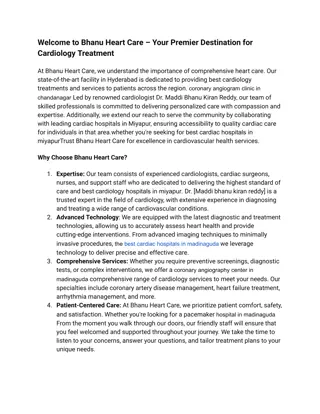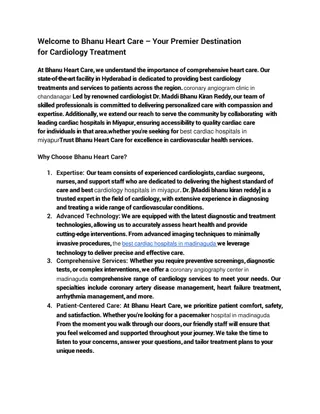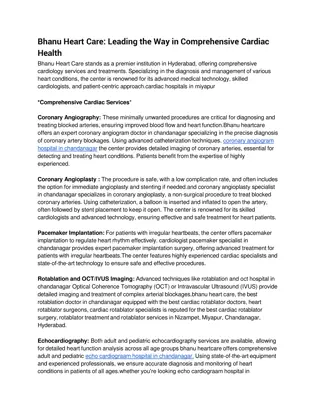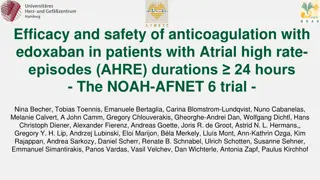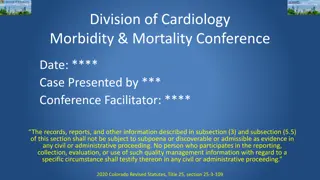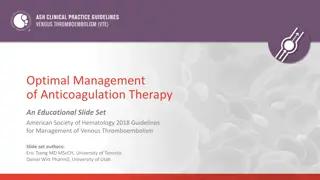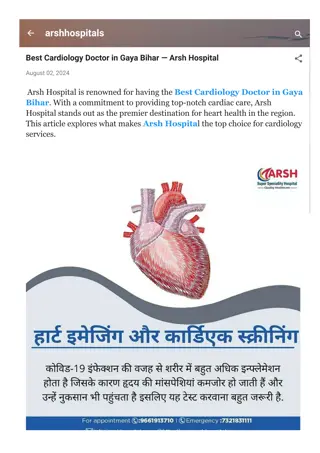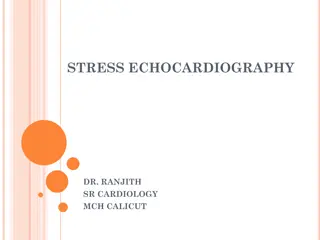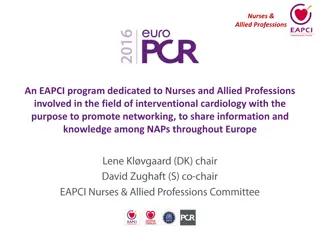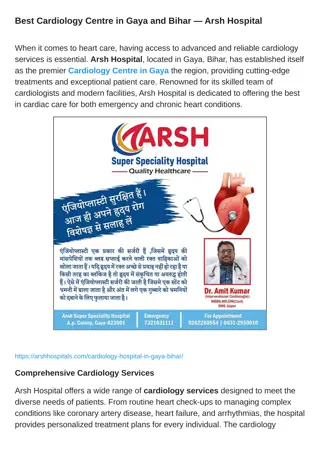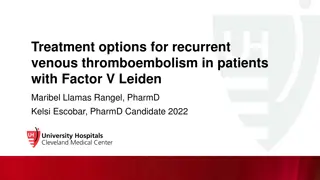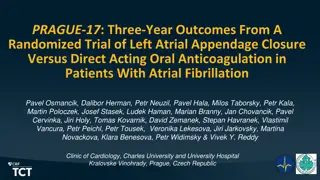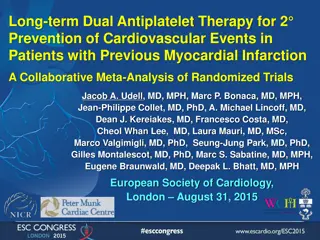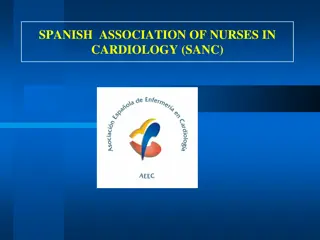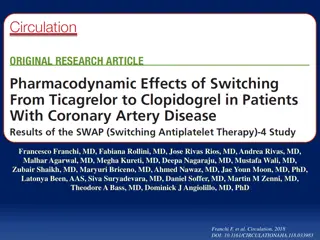Understanding Antiplatelet and Anticoagulation Therapy in Cardiology
This informative content covers the current practice guidelines and medication options for antiplatelet therapy in CAD patients, discussing different medications, optimal duration of therapy, CV risk assessment, and anticoagulation options in atrial fibrillation. It delves into the role of aspirin in primary prevention and provides recommendations based on specific risk factors. Detailed information on antiplatelets, their targets, and aspirin's effectiveness in reducing cardiovascular events is also outlined.
Download Presentation

Please find below an Image/Link to download the presentation.
The content on the website is provided AS IS for your information and personal use only. It may not be sold, licensed, or shared on other websites without obtaining consent from the author. Download presentation by click this link. If you encounter any issues during the download, it is possible that the publisher has removed the file from their server.
E N D
Presentation Transcript
Antiplatelet and Anticoagulation Therapy What You Need to Know Sumith Aleti, MD, MPH, FACC OHHI Cardiology Group
Objectives Utilize current practice guidelines for the management of antiplatelet therapy in CAD patients. Discuss the selection of different antiplatelet medications Determine optimal duration of Dual Antiplatelet therapy Assess CV risk vs bleeding risk Recognize options of of anticoagulation in atrial fibrillation
Antiplatelet Antiplatelet Therapy: Targets Targets Therapy: Dipyridamole Cilostasol Clopidogrel bisulfate Ticlopidine hydrochloride Prasugrel hydrochloride Ticagrelor Phosphodiesterase ADP ADP Gp 2b/3a Inhibitors Collagen Thrombin TXA2 Activation COX TXA2 Aspirin ADP=Adenosine diphosphate, COX=Cyclooxygenase, TXA2=Thromboxane A2 Source: Schafer AI. Antiplatelet Therapy. Am J Med 1996;101:199 209
Aspirin for Primary Prevention Aspirin for Primary Prevention Aspirin reduces the risk of myocardial Infarction among men (Physician s Health Study (PHS) Aspirin does not reduce cardiovascular events among women (Women s Health Study) Aspirin decreases risk of ischemic stroke in woman but not in men. Aspirin does not reduce the risk of adverse CV events in diabetics (POPADAD study and Japanese PAD study) Aspirin reduces the risk of MI and vascular events at the expense of bleeding (ATT collaboration)
Aspirin Recommendations Aspirin Recommendations Primary Prevention I IIa IIb III B Aspirin (81 mg daily or 100 mg every other day) in at risk women >65 years of age I IIa IIb III B Aspirin in at risk women <65 years of age for ischemic stroke prevention I IIa IIb III B Aspirin in optimal risk women <65 years of age Source: Mosca L et al. Circulation 2007;115:1481-1501
Aspirin Recommendations (Continued) Aspirin Recommendations (Continued) Primary Prevention I IIa IIb III A Aspirin (75-162 mg daily) in [men]* at intermediate risk (10-year risk of CHD >10%) I IIa IIb III B For diabetics only for (10-year risk >10%) and formen >50 years of age or women >60 years of age who have at least one additional major risk factor Low-dose aspirin (75-162 mg/day) may be considered for those with DM at intermediate CVD risk (younger patients with >1 risk factors* or older patients with no risk factors*, or patients with a 10-year risk of 5-10%. I IIa IIb III Includes those with family history of premature CVD, hypertension, smoking, dyslipidemia, or albuminuria *Specific guideline recommendations for men do not exist, but these guidelines are based on previous general (not gender specific) primary prevention guidelines CHD=Coronary heart disease Source: Pearson TA et al. Circulation 2002;106:388-391
Aspirin Evidence: Aspirin Evidence: Secondary Prevention Secondary Prevention Effect of antiplatelet treatment* on vascular events** Category% Odds Reduction Acute MI Acute CVA Prior MI Prior CVA/TIA Other high risk CVD (e.g. unstable angina, heart failure) PAD (e.g. intermittent claudication) High risk of embolism (e.g. Afib) Other (e.g. DM) All trials 2.0 0.0 0.5 1.0 1.5 Antiplatelet better Antiplatelet better Control better Control better Aspirin reduces the risk of adverse cardiovascular events *Aspirin was the predominant antiplatelet agent studied **Include MI, stroke, or death Source: Antithrombotic Trialists Collaboration. BMJ 2002;324:71 86
Clopidogrel Clopidogrel: : Secondary Prevention Secondary Prevention Clopidogrel provides slightly greater risk reduction than aspirin DAP therapy produces greater benefit when used for 1 year in NSTE-ACS patients DAP therapy produces greater benefit when used for 1 year in post PCI patients. DAP therapy produces greater benefit in medically managed STEMI patients Routine use of DAP for high risk patients showed no benefit over aspirin alone.
Prasugrel Prasugrel Evidence: Evidence: Secondary Prevention Secondary Prevention Trial to Assess Improvement in Therapeutic Outcomes by Optimizing Platelet Inhibition with Prasugrel (TRITON-TIMI 38) 13,608 patients with high-risk ACS scheduled for PCI randomized to clopidogrel (300 mg LD and 75 mg MD) or prasugrel (60 mg LD and 10 mg MD) for a median of 12 months 12.1 HR 0.81, P=0.0004 CV death, MI, or stroke % 11 Clopidogrel 9.9 Bleeding Events 9 TIMI major Life threatening Nonfatal Fatal ICH C (%) P (%) P-value 1.8 2.4 .03 0.9 1.4 .01 0.9 1.1 .23 0.1 0.4 .002 0.3 0.3 .74 Prasugrel 7 5 HR 0.77 P=.001 HR 0.80 P=.001 0 0 30 60 90 180 270 360 450 Days Prasugrel reduces ischemic events with a higher rate of bleeding ACS=Acute coronary syndrome, ICH=Intracranial hemorrhage, LD=Loading dose, MD=Maintenance dose Source: Wiviott SD et al. NEJM 2007;357:2001-2015
Prasugrel Prasugrel Evidence: Evidence: Secondary Prevention Secondary Prevention Targeted Platelet Inhibition to Clarify the Optimal Strategy to Medically Manage Acute Coronary Syndromes (TRILOGY-ACS) 7243 patients with a medically managed NSTE-ACS randomized to prasugrel (10 mg) or clopidogrel for up to 30 months 20 CV Death, Nonfatal MI, and 16.0% Nonfatal Stroke (%) Clopidogrel 13.9% 10 Prasugrel HR=0.91, P=0.21 0 0 360 720 Time (Days) Prasugrel does not provide benefit in medically managed NSTE-ACS CV=Cardiovascular, MI=Myocardial infarction, NSTE- ACS=Non-ST-segment elevation acute coronary syndrome Source: Roe, MT et al. NEJM 2012;367:1297-1309
Prasugrel Prasugrel: Summary : Summary Intervention P2Y12 Choice No benefit of prasugrel over clopidogrel, except in pts undergoing angiography Medical management Invasive management PCI with no risk of bleeding complications In patients 75 years of age, <60 kg in weight, or with prior transient ischemic attack (TIA) or stroke, Prasugrel is not recommended Reasonable t prefer prasugrel* over clopidogrel[1] *In pts with no prior stroke or TIA. 1. Amsterdam EA, et al. Circulation. 2014;130:2354-2394.
Ticagrelor Ticagrelor Evidence: Evidence: Secondary Prevention Secondary Prevention Platelet Inhibition and Patient Outcomes (PLATO) Study 18,624 patients with a moderate to high risk ACS randomized to clopidogrel (300-600 mg LD and 75 mg MD) or ticagrelor (180 mg LD and 90 mg twice daily MD) for 12 months 11.7 12 10 8 6 4 2 0 HR 0.84, p=0.001 Clopidogrel 9.8 CV Death, MI, or Bleeding Events* C (%) Stroke (%) Ticagrelor TIMI major/year 7.9 PLATO major/year Life threatening/year 5.8 Fatal/year T (%) 7.7 11.6 11.2 5.8 0.3 0.3 0 60 120 180 240 300 360 Days after randomization Ticagrelor reduces ischemic events with no higher rate of bleeding overall *No statistically significant differences were observed in bleeding rates overall ACS=Acute coronary syndrome, CV=Cardiovascular, LD=Loading dose, MD=Maintenance dose Source: Wallentin L et al. NEJM 2009;361:1045-1057
PLATO: CV Death, MI, or Stroke in ACS Pts With or Without Invasive Strategy Invasive (coronary angiography followed by revascularization) Ticagrelor +ASA (n = 6732) Clopidogrel + ASA (n = 6676) 20 Noninvasive Ticagrelor + ASA (n = 2601) Clopidogrel + ASA (n = 2615) CV Death, MI, or Stroke (%) 16 14.3% Noninvasive HR: 0.85 (95% CI: 0.73-1.0) 12.0% 10.7% 12 9.0% 8 Invasive HR: 0.84 (95% CI: 0.75-0.94) 4 0 0 60 120 180 240 300 360 Days After Randomization James SK, et al. BMJ. 2011;342:d3527
PEGASUSTIMI 54: CV Death, MI, or Stroke in Pts With Prior MI and 1 Risk Factor* 10 N = 21,162 Median follow-up: 33 mos Placebo Ticagrelor 90 mg Ticagrelor 60 mg 9.0% 7.8% 7.8% CV Death, MI, or Stroke (%) 8 6 Ticagrelor 90 mg HR: 0.85 (95% CI 0.75-0.96; P = .008) 4 Ticagrelor 60 mg HR: 0.84 (95% CI 0.74-0.95; P = .004) 2 0 0 6 12 18 24 30 36 Mos From Randomization *65 yrs of age or older, diabetes, second prior MI, multivessel CAD, or chronic non-end stage renal dysfunction. Bonaca MP, et al. N Engl J Med. 2015;372:1791-1800.
PEGASUSTIMI 54: Components of Primary Endpoint P Value Endpoint HR (95% CI) 0.85 (0.75-0.96) 0.84 (0.74-0.95) 0.84 (0.76-0.94) .008 .004 .001 CV Death, MI, or Stroke (1558 events) 0.87 (0.71-1.06) 0.83 (0.68-1.01) 0.85 (0.71-1.00) .15 .07 .06 CV Death (566 events) 0.81 (0.69-0.95) 0.84 (0.72-0.98) 0.83 (0.72-0.95) .01 .03 .005 MI (898 events) 0.82 (0.63-1.07) 0.75 (0.57-0.98) 0.78 (0.62-0.98) .14 .03 .03 Stroke (313 events) 0.4 0.6 0.8 1 1.25 1.67 Ticagrelor 90 mg Ticagrelor 60 mg Pooled Ticagrelor Better Placebo Better Bonaca MP, et al. N Engl J Med. 2015;372:1791-1800.
Bleeding vs Ischemic risk Ferreiro et al Thromb Haemost 2010; 103: 1128 1135
Lets simplify Aspirin dose in PCI patients 81 is enough Regardless of stent type ideal duration is 1 year DAPT in PCI for Stable ischemic heart disease DAPT in PCI for ACS patients Bleed risk (previous bleed on DAPT, on oral anticoagulation, has coagulopathy etc)
Stable Ischemic Heart disease DAPT consists of ASA + Clopidogrel Bare metal 1 month minimum Current DES stents 6 months minimum If no bleed risk continue longer in both groups. May be reasonable to stop P2Y12inh after 3 months if patient developed significant overt bleeding, or at risk for severe bleeding complication (e.g. major intracranial surgery)
ACS patients At least 12 months for both BMS and DES patients. Reasonable to prefer Ticagrelor over Clopidogrel Reasonable to prefer Prasugrel over Clopidogrel if patient not at high bleeding risk and do not have CVA If no bleeding complication or bleed risk low, may continue longer than 12 months. DES patients may discontinue P2Y12 after 6 months if high bleed risk.
ACC/AHA Guidelines 2014 Antithrombotic therapy is recommended for all patients with atrial fibrillation except those with low risk (grade IA) Use CHA2DS2-VASC score to calculate CVA risk in nonvalvular afib (grade IA) Assessment of bleeding risk should be done when prescribing oral anticoagulation therapy (grade IA) Where oral anticoagulation indicated, a DOAC should be used instead of warfarin (grade IIA)
CHA2DS2VASC & Risk Stratification Definition CHA2DS 2VASC Score Total Adjusted Stroke Rate (% per year) Based on CHA2DS2VASC Score* CHA2DS2VASC Score 0 0 Congestive heart failure 1 1 1.3 Hypertension 1 2 2.2 Age >75 2 3 3.2 Diabetes mellitus 1 4 4.0 Stroke, TIA, thromboembolism 2 5 6.7 Vascular disease 1 6 9.8 Age 65-74 1 7 9.6 Sex (female) 1 8 6.7 9 15-20 *AHA/ACC 2014 atrial fibrillation guidelines 27
When to Anticoagulate Using the CHA2DS2VASC score: Score of 0 = no anticoagulation Score of 1 = none (if point awarded for gender only), or aspirin, or oral anticoagulation Score of >2 = oral anticoagulation *AHA/ACC 2014 atrial fibrillation guidelines 28
Direct Oral Anticoagulation (DOAC) Examples Direct thrombin inhibitor Dabigatran (Pradaxa) Direct factor Xa inhibitor Rivaroxaban (Xarelto) Apixaban (Eliquis) Edoxaban (Savaysa) Betrixaban (Bevyxxa) 29
Warfarin Preferred for patients with: Mechanical heart valves Valvular afib: mitral stenosis or mitral valve replacement Breastfeeding End stage renal disease 30
Conclusions DAPT is indicated at least for one year after ACS Duration of antiplatelet therapy is based on ischemic vs bleed risk Newer generation stents, DAPT duration shorter in special situations In patients with prior MI, benefit with extending DAPT beyond one year Calculate bleeding risk for ischemic risk in assessing duration



